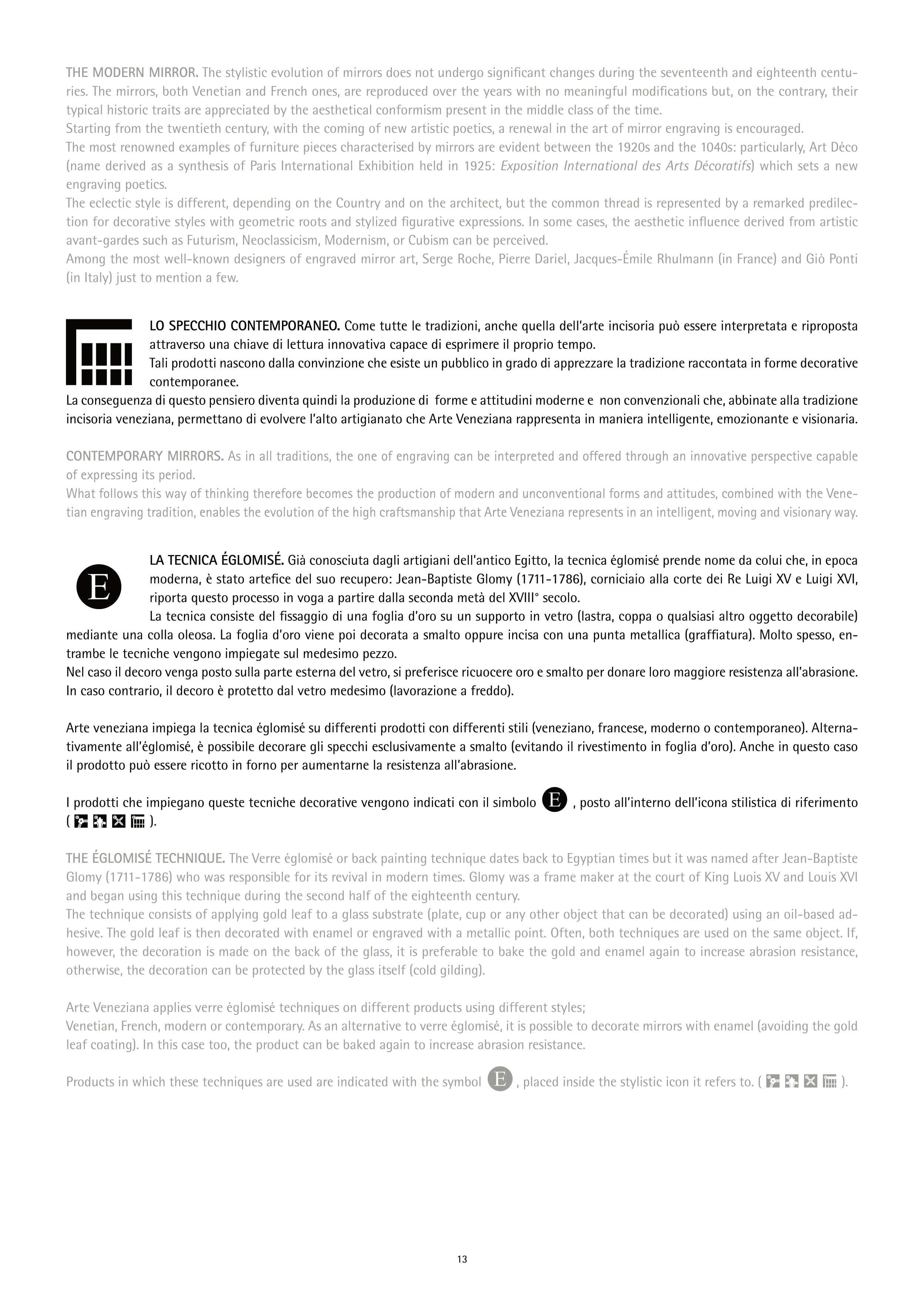LO SPECCHIO CONTEMPORANEO. Come tutte le tradizioni, anche quella dell’arte incisoria può essere interpretata e riproposta
attraverso una chiave di lettura innovativa capace di esprimere il proprio tempo.
Tali prodotti nascono dalla convinzione che esiste un pubblico in grado di apprezzare la tradizione raccontata in forme decorative
contemporanee.
La conseguenza di questo pensiero diventa quindi la produzione di forme e attitudini moderne e non convenzionali che, abbinate alla tradizione
incisoria veneziana, permettano di evolvere l’alto artigianato che Arte Veneziana rappresenta in maniera intelligente, emozionante e visionaria.
CONTEMPORARY MIRRORS. As in all traditions, the one of engraving can be interpreted and offered through an innovative perspective capable
of expressing its period.
What follows this way of thinking therefore becomes the production of modern and unconventional forms and attitudes, combined with the Vene-
tian engraving tradition, enables the evolution of the high craftsmanship that Arte Veneziana represents in an intelligent, moving and visionary way.
THE MODERN MIRROR. The stylistic evolution of mirrors does not undergo significant changes during the seventeenth and eighteenth centu-
ries. The mirrors, both Venetian and French ones, are reproduced over the years with no meaningful modifications but, on the contrary, their
typical historic traits are appreciated by the aesthetical conformism present in the middle class of the time.
Starting from the twentieth century, with the coming of new artistic poetics, a renewal in the art of mirror engraving is encouraged.
The most renowned examples of furniture pieces characterised by mirrors are evident between the 1920s and the 1040s: particularly, Art Déco
(name derived as a synthesis of Paris International Exhibition held in 1925: Exposition International des Arts Décoratifs) which sets a new
engraving poetics.
The eclectic style is different, depending on the Country and on the architect, but the common thread is represented by a remarked predilec-
tion for decorative styles with geometric roots and stylized figurative expressions. In some cases, the aesthetic influence derived from artistic
avant-gardes such as Futurism, Neoclassicism, Modernism, or Cubism can be perceived.
Among the most well-known designers of engraved mirror art, Serge Roche, Pierre Dariel, Jacques-Émile Rhulmann (in France) and Giò Ponti
(in Italy) just to mention a few.
LA TECNICA ÉGLOMISÉ. Già conosciuta dagli artigiani dell’antico Egitto, la tecnica églomisé prende nome da colui che, in epoca
moderna, è stato artefice del suo recupero: Jean-Baptiste Glomy (1711-1786), corniciaio alla corte dei Re Luigi XV e Luigi XVI,
riporta questo processo in voga a partire dalla seconda metà del XVIII° secolo.
La tecnica consiste del fissaggio di una foglia d’oro su un supporto in vetro (lastra, coppa o qualsiasi altro oggetto decorabile)
mediante una colla oleosa. La foglia d’oro viene poi decorata a smalto oppure incisa con una punta metallica (graffiatura). Molto spesso, en-
trambe le tecniche vengono impiegate sul medesimo pezzo.
Nel caso il decoro venga posto sulla parte esterna del vetro, si preferisce ricuocere oro e smalto per donare loro maggiore resistenza all’abrasione.
In caso contrario, il decoro è protetto dal vetro medesimo (lavorazione a freddo).
Arte veneziana impiega la tecnica églomisé su differenti prodotti con differenti stili (veneziano, francese, moderno o contemporaneo). Alterna-
tivamente all’églomisé, è possibile decorare gli specchi esclusivamente a smalto (evitando il rivestimento in foglia d’oro). Anche in questo caso
il prodotto può essere ricotto in forno per aumentarne la resistenza all’abrasione.
I prodotti che impiegano queste tecniche decorative vengono indicati con il simbolo
, posto all’interno dell’icona stilistica di riferimento
( ).
THE ÉGLOMISÉ TECHNIQUE. The Verre églomisé or back painting technique dates back to Egyptian times but it was named after Jean-Baptiste
Glomy (1711-1786) who was responsible for its revival in modern times. Glomy was a frame maker at the court of King Luois XV and Louis XVI
and began using this technique during the second half of the eighteenth century.
The technique consists of applying gold leaf to a glass substrate (plate, cup or any other object that can be decorated) using an oil-based ad-
hesive. The gold leaf is then decorated with enamel or engraved with a metallic point. Often, both techniques are used on the same object. If,
however, the decoration is made on the back of the glass, it is preferable to bake the gold and enamel again to increase abrasion resistance,
otherwise, the decoration can be protected by the glass itself (cold gilding).
Arte Veneziana applies verre églomisé techniques on different products using different styles;
Venetian, French, modern or contemporary. As an alternative to verre églomisé, it is possible to decorate mirrors with enamel (avoiding the gold
leaf coating). In this case too, the product can be baked again to increase abrasion resistance.
Products in which these techniques are used are indicated with the symbol
, placed inside the stylistic icon it refers to. ( ).
13


